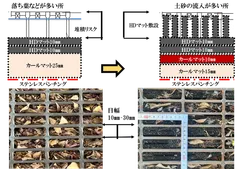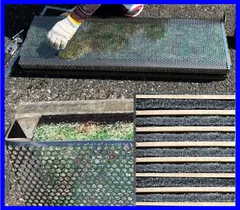Aiming to create a city free of the spread of mosquito-borne infectious diseases! Released an improved version of ultra-fine sorting grating and sorting water collection mat
SDG approach to simultaneously improve trash accumulation & mosquito breeding problems in stormwater catch basins.
一般社団法人 産学技術協会
Japan Association of Industrial and Academic Technology (Location: Chiyoda-ku, Tokyo; President: Tetsuo Suda) has released improved versions of its ultra-fine sorting grating "GOMIIRAN (for U-shaped ditches)" and "KAHAIREN (for rainwater catch basins)," which prevent the inflow of fallen leaves and sediment and the entry and exit of mosquitoes, and its sorting water collection mat "Mosquito Extinction Mat," with the aim of creating cities free of the spread of mosquito-borne infectious diseases. The improved versions of "KAHAIREN (for rainwater catch basins)" and "Mosquito Extinction Mat" were released on May 2, 2024, with the aim of creating a town without the spread of mosquito-borne infectious diseases.
URL of "Creating a town without the spread of mosquito-borne infectious diseases": https://sangaku.org/development.html

Main
Background of Development
Urban properties are equipped with catch basins for proper drainage of rainwater, and efforts are being made by professional maintenance managers to maintain design performance. However, the problem of mosquito breeding and sediment buildup in stormwater catch basins still remains unresolved, as well as the inability to maintain the design drainage gradient.
One factor that has been cited as a contributing factor is the cleaning interval of the mud puddles. Although the cleaning is done to maintain drainage performance, the puddles that remain after rainfall after cleaning are ideal for mosquito spawning sites, promoting mosquito proliferation and becoming the leading point of mosquito-borne disease transmission. (SDG 3 case study, dengue fever spread from Yoyogi Park in 2014)
In addition, the current chemical countermeasures are causing concerns about water quality, which is a concern when rainwater is used. In addition, by allowing the inflow of sediment, fallen leaves, etc., sediments are created, which flow into the public sewage system during heavy rains, placing a burden on the sewage treatment system. (SDG 14 case study, strange odor at the Tokyo 2020 Olympic Triathlon venue)
The reason for allowing non-rainwater is that it is virtually impossible to open and close the grating at the catch basin an adequate number of times from the standpoint of manpower, safety, and budget.
To solve these problems, it is necessary to severely limit the inflow of non-rainwater. For example, by using ultra-fine grating with separate water collection, the maintenance cycle can be shifted from a situation where it is difficult to check the drainage channel under the grating to a situation where it is always visible on the grating, allowing management to start on the day after the rain stops, with light daily work, reducing costs and environmental impact. This will enable cost reduction and environmental impact reduction.
We believe that now is the time to make a decision to promote environmental improvement of rainwater catchment and drainage channels that are familiar to us for the sake of future generations. The consideration for the earth by each and every one of us will lead to the realization of a more sustainable urban environment.
Thoughts on Product Development
Rainwater catch basins are an important part of the urban water cycle infrastructure, aiming to collect rainwater, use it in a clean condition, and eventually return it to the sea. However, in the current situation, rainwater catch basins have become temporary trash cans, degrading water quality before returning it to the ocean. This situation is the result of a problem with the maintenance and management system.
We developed this system in the hope of spreading the use of ultrafine fractional catch basins, which can be corrected for correct maintenance and management. Currently, the catch basins use grating trout eyes that allow the inflow of sediment and fallen leaves, which begin to accumulate when the rain stops. This causes the designed drainage gradient to collapse, resulting in further sedimentation and a situation where the drainage channel is covered with sludge.
In addition, the sludge in the stormwater catch basins can become a breeding ground for mosquitoes when cleaned, creating an unwanted mosquito-borne disease transmission point in a country that aims to be a tourist nation. Furthermore, some of the sludge flows out during heavy rains, putting a strain on sewage treatment plants. This inefficient situation hinders fundamental solutions to the SDGs.
Therefore, we would like to promote awareness of the problem of rainwater catchment channels by visualizing the waste through ultra-fine sorting and collection. Through this initiative, we aim to contribute to environmental conservation in urban areas along with the realization of a sustainable water cycle.
■Recent Social Situation
As Japan aims to become a tourism-oriented country, we expect that measures to increase the number of foreign visitors to Japan will continue to be taken. However, important issues remain regarding the environment for the prevention of infectious diseases. Looking at the number of adult human striped dengue fever cases over time, the spread of dengue fever from Yoyogi Park in 2014 occurred at a time when the 23 wards of Tokyo had a low population of the disease. Based on the current trends, it is assumed that there is no preventive effect and that the spread of the disease continues to be possible anytime an infectious agent is brought into the area. Particular attention should continue to be paid to the Zika virus, which spread globally from Brazil in 2016, as it is transmitted through the human striped dolphin. The risk of infection is always high in Tokyo, especially in the 23 wards of the city, which are visited by many foreigners, because they are home to more than three times as many human shimadka as the Tama area. In addition, the incubation period of the Zika virus is from 2 to 12 days, and it is believed that many people do not show symptoms, so there is a risk of infection spreading with little awareness of infection. Furthermore, sexual transmission has also been confirmed, and it has been reported that when pregnant women are infected, their fetuses may be left with disabilities and many microcephalic children may be born with microcephaly.
Therefore, it is important to make sure that rainwater basins, which are mosquito breeding points in places where people gather, are mosquito-proof. If infection is confirmed, the tourism industry and the Japanese economy could again be severely impacted, so it is imperative that all preventive measures be taken. It is important to learn from the lessons of the spread of the new coronas and take all possible preventive measures.
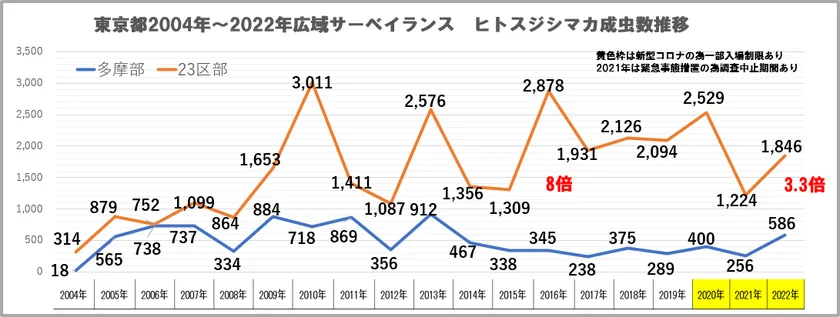
*Tokyo Metropolitan Wide-Area Surveillance Data for 19 years in chronological order
■Product response locations (locations where residents felt uneasy)
I dropped an earring from the grating of a rainwater catch basin, and when I asked them to pick it up, they found it in the sludge with a strange odor and could not put it on immediately. I would like to have the water collected in a very fine sorting system.
The other day I dropped my car keys on the grating in the parking lot. It took me a long time to open it because it was covered with anti-theft measures. The grating is rarely opened or it is difficult to open, so it is necessary to make it a very fine sorting water collector.
Some people still throw cigarettes into rainwater catch basins and U-shaped ditches, thinking it is good because they can see the garbage inside. They think it's good because they can see the garbage inside. If they can see the garbage inside, they may change their minds.
I am concerned that the drainage may be obstructed during heavy rainfalls. It is worrisome that the designed drainage gradient is not always maintained. Garbage inflow is irrational and should be protected by ultra-fine separation and collection.
I want to use rainwater, but I was worried about the inflow of garbage, fallen leaves, dead insects, and mosquitoes laying eggs through the catchment, but it seems that there is nothing to worry about with ultra-fine sorted water catchment.
I was worried about the inflow of garbage, fallen leaves, dead insects, and mosquitoes from the catchment, but I am not worried about that with ultra-fine sorted water catchment.
When I was talking on a bench in the park, mosquitoes were coming out of a nearby stormwater basin. I think it would be good to have an ultra-fine fractionated water catchment that would make it impossible for mosquitoes to breed, since they come to the park unprotected and with their children.
I don't want to imagine mosquitoes breeding in the rainwater catch basins of factories that produce food and medicine, but the local residents are concerned about the chemical damage that is being caused by the use of chemicals.
I don't want to go to the hospital and get bitten by mosquitoes, nor do I want to pass on infectious diseases. I don't want to be bitten by mosquitoes or catch an infectious disease when I go to the hospital. The rainwater catchment basin at the hospital should be a very fine sorting and collecting system.
At least, the rainwater catchment basin in my hotel's premises should be designed to collect water in a very fine fraction so that mosquitoes do not breed.
My property is adjacent to a park. I don't know if they are taking measures against mosquitoes, but I have a feeling that they are escaping into my house as well. I don't know if they are taking measures against mosquitoes, but I feel that they are escaping into the park.
I think it is very difficult to manage rainwater catch basins in schools, and rainwater catch basins in schools should be separated and collected in a very fine manner to prevent mosquito-borne infections among children.
If there are mosquitoes in the school's rainwater catchment basin, it will be an environment where mosquitoes can easily infect the students.
Outline of the product
For rainwater catch basins
Separated water collection mat filling type
Filled according to the shape of the existing rainwater catchment basin, it immediately prevents mosquito breeding.
Separate water collection mat SS type
This product is designed to match the shape of existing grating to prevent mosquitoes and fallen leaves from flowing into the grating.
Ultra-fine sorting grating = KAHIREN
This product is integrated with grating and prevents inflow of mosquitoes and fallen leaves for the purpose of new installation or replacement.
For U-shaped ditches
Separated water collection mat SS type
This product is designed to match the shape of existing grating to prevent mosquitoes and fallen leaves from flowing into the grating.
Ultra-fine sorting grating = GOMIIRAN
This product is integrated into the grating and prevents mosquitoes and fallen leaves from flowing into the grating for the purpose of new installation or replacement.
For eave gutters
Eave gutter drainage revolution
This product prevents eave gutters from clogging, improves the efficiency of gutter heaters in snowy areas, and realizes stable rainwater utilization.

Ultra-fine grating: Separate water-collecting mat SS type, Separate water-collecting mat filled type, Eaves gutter drainage revolution
Customer's voice: I want the accumulation inside the grating to be eliminated as well.
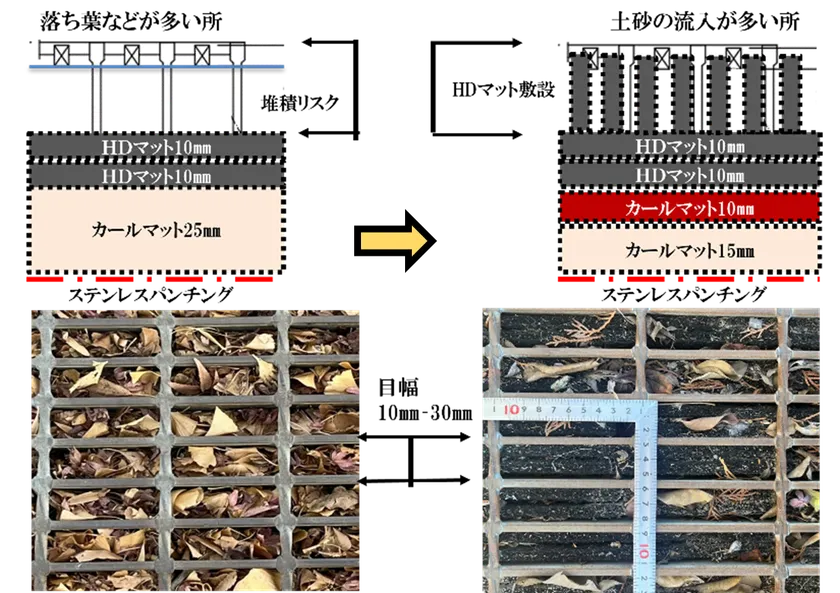
Improvement of conventional product in response to customer requests/HD mat vertically reinforced
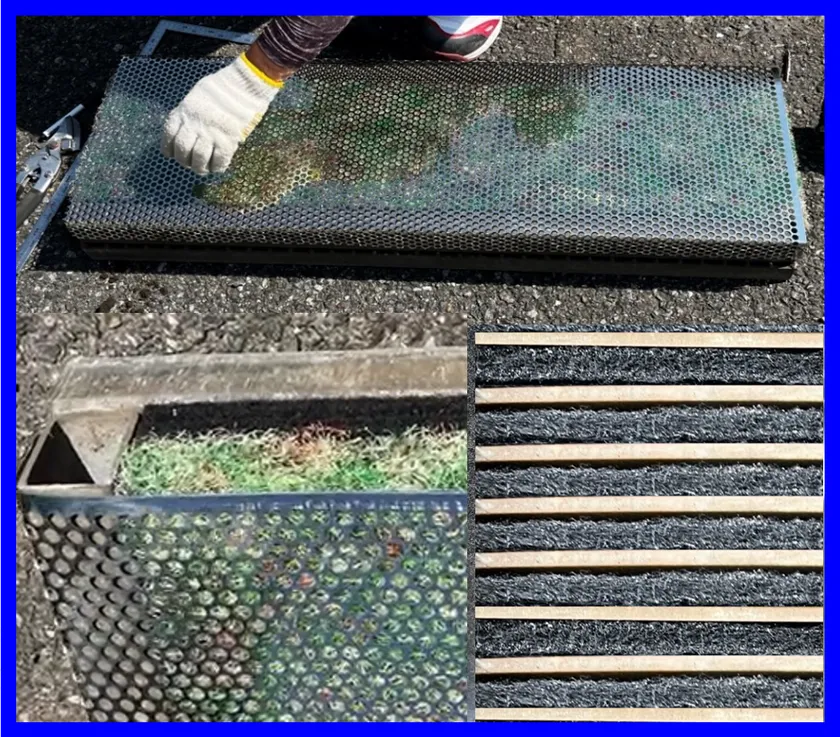
Ultrafine sorting grating [HD vertical standard
Product Name : Ultra-fine sorting grating (made-to-order) and existing sorting water collection mat
Product Name : Ultrafine grating (made-to-order) and existing separate water collecting mats
Type : For U-shaped ditches = GOMIIRAN : For rainwater catch basins = KAHAIREN
Type : For U-shaped ditches and rainwater catch basins = Separate water collection mat SS type s
For rainwater catch basins = Separate water collection mats filled type
Eaves gutter drainage revolution
Price: From 57,151 yen (tax included)
Contents : From 1 piece (made-to-order)
Size: For U-shaped ditches: 200 mm to 500 mm wide (including the frame),
For rainwater catch basins: 200 mm square to 500 mm square (including frame)
Material : Grating, plated frame, perforated stainless steel,
Nonwoven fabric (polyester, vinyl chloride)
Sales locations: SK Material Corporation, Matex Kenzai Co,
Earth Frontier Corporation, Yushin Co.
URL : https://sangaku.org/Pamphlet20240420.pdf (detailed information)
To those who wish to cooperate in construction and sales, and to those who wish to confirm product details
Please contact the Secretariat of the Association for the Design and Construction Management of Separated Water-Collecting Mat within the Association of Industrial and Academic Technology.
Company Profile
Company name: Sangaku Gijutsu Gijutsu Kyokai (Japan Society of Industrial Science and Technology)
Representative: Tetsuo Suda, President
Address: Resona Kudan Bldg. 5F, 1-5-6 Kudan-Minami, Chiyoda-ku, Tokyo 102-0074, Japan
Resona Kudan Bldg. 5F KS Floor
Establishment: September 2014
URL: https://sangaku.org/news.html
For customer inquiries regarding this matter, please contact
Japan Society of Industrial and Academic Technology
For inquiries, please contact the secretariat of the Association for Design and Construction Management of Separate Water-Collecting Mats
TEL : 03-6869-3502
MAIL: aiuto_lab@sangaku.org
- Category:
- Goods
- Genres:
- Technology Economy(Japan) Nature & Ecology



